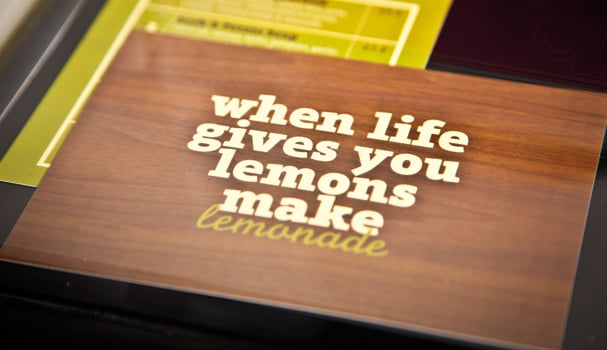With technology taking over our lives to an unprecedented degree, one could be forgiven for dismissing the humble business card as a relic of times gone by. However, it would appear that consigning the business card to history is a dangerous game indeed as, in the eyes of many a business mogul, it is more relevant now than ever before.
It will probably come as little surprise to learn that Richard Moross sits firmly in this camp. Of course, the unbridled success of his enterprise moo.com would seem in itself to suggest that the business card is here to stay. However, it also serves to emphasise that its purpose has evolved, and that the contemporary small business owner must have his or her eyes open to this evolution. “Like every technology, it has got to evolve, it has got to be related to the internet, it has got to be related to technology in some way, and there are lots of ways in which it can do that,” says Moross.
An example of this is provided by Bev James, CEO of business training provider The Coaching Academy. “I have had three different cards in the last 18 months,” she explains. “When the QR codes were popular, I put a QR code on my business card and that was quite novel, it was a talking point. They are not as trendy now so I have taken it off.”

In that sense then, far from attempting to compete with technology, the digital revolution has merely opened up myriad opportunities for companies looking to keep their business card in tune with reality. For instance, moo.com’s partnerships with Facebook and Flickr allow users to personalise their cards like never before. Its ‘printfinity’ technology means they can select a different social media image for each of the 20, 50 or 100 cards they order.
Intriguingly, if one breaks a business card down to its most basic function, it continues to operate with minimal competition. “It still exists in an era of all kinds of other technological devices, and it exists because it doesn’t need batteries, it doesn’t need a Wi-Fi connection, it doesn’t need a software upgrade,” says Moross. “It is very straightforward and very simple, and often the simplest ideas and simplest products are the most enduring, the most powerful and the most useful.”
In a wider sense, though, a business card is a core marketing avenue for a person’s enterprise – and the modern business-owner is thus missing a trick if they aren’t keeping their brand in mind when designing their card. “I think that for many small businesses, it is the shop window, it is the advertising, it might be the only marketing that they do,” Moross continues. “So, it might not even be an extension of their brand identity, it might be the core, the one place it is actually expressed. It therefore plays a very vital role in conveying what a brand stands for, what a company is about, and what its values are.”

On another level, a business card should also offer a fair reflection of the person handing it out, suggests Moross. “Business cards are a token, they have heft and weight, and are a physical and tactile thing, so they express, to some extent, the approach that the owner has taken when investing in this piece of design,” he explains. “They are also obviously visually designed, so more than just the contact details and the person’s name, a business card conveys what they are about, what their style is like, and how they convey themselves.”
If we assume, then, that a business card is a key expression of one’s brand identity, the care and attention given to its design should naturally be mirrored in the way it is utilised. At least, that’s what James believes. “If you are going to give a card, then it needs to have a purpose,” she says. “Just saying ‘have my card’ means nothing. It is far better to say, ‘I’ll give you my card, can I take yours?’ and then agree what you are both going to do as a result of that. Otherwise I just think it is all a bit pointless.”
Indeed, the exchange of business cards is a staple of many a conference or networking event. And for a small-business owner looking to go places, a memorable business card can help turn that initial contact with a potential client into something more substantial. “There is nothing else that you are going to get into the hands of your customers as often as a business card, so it is a critical piece of real estate in your communications base,” says Anthony Ganjou, founder and CEO of out-of-home media agency CURB Media. “It is something shared by the people who you have given it to, so when you are not there, it is the representative element of you, and the first impression of your business.”
Needless to say, an entrepreneur must be careful not to innovate for the sake of it. At the end of the day, a flashy business card won’t save a struggling enterprise. “I think the business card is just a piece of media – it can only work as hard as the business it is trying to sell,” says Moross. “But I think there are lots of amazingly exciting businesses out there that just need help telling their story.” One thing is for sure though: the story of the business card is far from over.
A magic touchpoint
Anthony Ganjou, founder and CEO of CURB Media, explains the idea behind his innovative business card:

“At CURB, we exist to inspire and amaze our audience, so we invest heavily in creating a unique business card that is both memorable and, critically, a shareable point of conversation. So what do our cards do? Well, mine physically grow into mint, daisies and even carrots. All you need to do is soak them in water and plant in soil. Ultimately, in today’s digital world, details can be kept in seconds online or via mobile, leaving our cards to be the one thing our clients talk about after every meeting and thus providing a long-term engagement opportunity. It is about ways in which we can make every touchpoint between our brand and our consumers as magic, or as amazing, as possible.” ![]()
Share via:








































